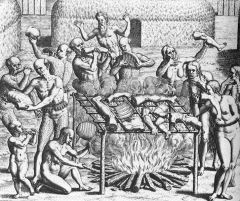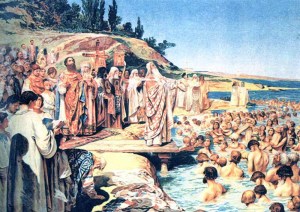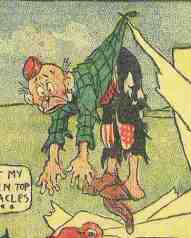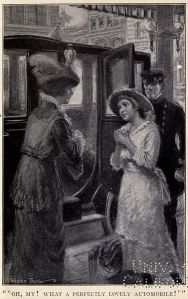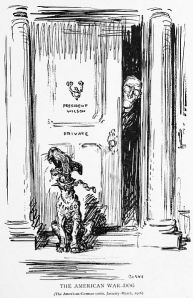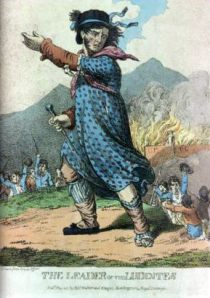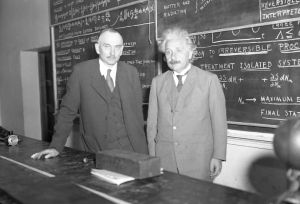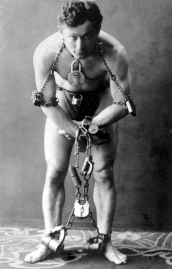
In the red corner, we have … STAND-ALONE PRONOUN; in the blue corner, we have … HOLD-MY-HAND DETERMINER.
They are both grammatical function words, but they have different roles. A determiner is part of the modification in a noun phrase; a pronoun is a noun phrase – it could be replaced with a single noun, or with a modified noun.
This battle will help you to avoid the hazards of mislabelling …
1. The red corner: pronouns
Pronouns stand alone because they REPLACE a noun and any modification linked to it.
The huge fighter in the red corner was very tall and looked quite ferocious. He looked like a winner.
In this example, the subject pronoun He REPLACES the modified noun in the subject site (The huge fighter). We can work out who He is by looking back to the previous sentence. This is called an anaphoric reference.
The excited crowds gave the man-mountain a rousing cheer. They had come to see him win.
In this example, the subject pronoun They REPLACES the modified noun in the subject site (The excited crowds); the object pronoun him REPLACES the modified noun in the object site (the man-mountain).
Sometimes, the pronoun reference can come before the noun. We have to work out the pronoun reference by looking forward to the next sentence. This is called a cataphoric reference. Delaying the noun can be used for semantic effect …
The fighter looked at her and paused. Man-mountain he may have been, but the determined young woman with steel in her eyes made him tremble.

The pronoun her is a broad, gendered reference and we may be tempted to make some stereotypical assumptions about the female character who catches the eye of the man-mountain! The next sentence, however, undermines this. The noun with its pre- and post-modification creates an amusing visual image: the great lump of a man reduced to jelly by the powerful gaze of a woman with a mission.
What subject, object and indefinite pronouns have in common is that they REPLACE nouns and any related modification. Pronouns are a closed set of words, so you can learn to recognise them.
Subject pronouns
Singular: I, you, he, she, it Plural: we, you, they
Object pronouns
Singular: me, you, him, her, it Plural: us, you, them
Indefinite pronouns
The atmosphere, the snacks, the music – everything was perfect.
The rowdy crowd were throwing toffee-coated popcorn and the man-mountain wanted some.
Other pronouns behave differently – they do not replace nouns, but support them.
Reflexive pronouns
Reflexive pronouns refer back to the subject of the sentence, or they can be used to give emphasis to a noun or pronoun.
The man-mountain shouted himself hoarse as he prepared for battle.
The crowd were getting manic, but the fight itself was very controlled.
Relative pronouns
Relative pronouns follow a noun and introduce relative clauses, which add extra information (post-modification).
The crowd who were baying at the ringside edged closer and closer as the tension grew.
2. The blue corner: determiners
Determiners are always used in partnership with a head noun (they hold hands!!).
They precede the noun, making the frame of reference definite or indefinite.
The man-mountain towered over the small referee. [definite]
Some people thought neither referee would survive. [indefinite]
Any bet on the man-mountain should be a surefire hit. [indefinite]
3. The battle: confusing times
Demonstrative (this, that, these, those) and possessive (his) forms can be confusing because the same terms are used for pronouns and determiners. This is where knowing the stand-alone vs holding-hands principle comes in useful …
This battle had been the best yet. The man-mountain was impressive and his record was outstanding. The evening was his – of that I was sure. This would be a night to remember.
The words in blue precede a noun and are therefore determiners; the words in red stand alone and are therefore pronouns. The possessive pronoun his refers back to the noun man-mountain, and the demonstrative pronoun This is an exophoric reference to the whole occasion (we need to be present – at the fight – to fully understand its field of reference). Exophoric references refer to something beyond the words themselves (extralinguistic).
Other possessive forms are different, but are still often confused.
Possessive determiners
Singular: my, your, his, her, its Plural: our, your, their
Possessive pronouns
Singular: mine, yours, his, hers, its Plural: ours, yours, theirs
If you look carefully, you will see that the pronoun forms usually have an -s ending. This is perhaps a remnant of the old genitive case inflection (possessive). It can be another way of checking whether a possessive word is a pronoun or a determiner.
4. Pronouns and determiners in action
The Emily Dickinson poem below uses determiners and pronouns in an interesting way to engage the reader. We have no clear field of reference for the terms, so the meaning is ambiguous. It allows readers to bring their own experiences to the text.

He fumbles at your Soul
As Players at the Keys
Before they drop full Music on –
He stuns you by degrees –
Prepares your brittle Nature
For the Ethereal Blow
By fainter Hammers – further heard –
Then nearer – Then so slow
Your Breath has time to straighten –
Your Brain – to bubble Cool –
Deals – One – imperial Thunderbolt –
That scalps your naked Soul –
When Winds take Forests in the Paws –
The Universe – is still –
Who are the participants?
(Look at the pronouns and determiners)
The content of this poem focuses on an interaction between two unnamed participants, but the third person pronoun He and the second person pronoun you and determiner your have no point of reference – we do not know who they are. In spite of this, there is a clear sense of opposition between the two. The gendered He seems dominant, appearing at the start of lines in the subject site, which gives the male participant agency. The second person references work on two levels: as direct address drawing the reader into the experience, and as an impersonal generic reference (where we would perhaps use ‘one’ in a formal context). The result is a feeling of detachment, making the second participant seem very much the victim.
How does the poet describe the events that drive the poem forward?
(Look at the verb phrases in the main clauses)
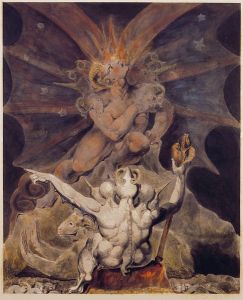 The poem is written in the present tense and the verb phrases are dynamic, carrying us through the intense experience at the heart of the poem. But there is no context. We have no idea of the occasion, the time or the place, and this makes the events ambiguous. Instead, we have to rely on the connotations of the verbs to interpret the process.
The poem is written in the present tense and the verb phrases are dynamic, carrying us through the intense experience at the heart of the poem. But there is no context. We have no idea of the occasion, the time or the place, and this makes the events ambiguous. Instead, we have to rely on the connotations of the verbs to interpret the process.
There is no title, no formal lead-in for the reader. Instead, we are thrown directly into a startling sequence of events. In the opening line, the prepositional verb fumbles at suggests a clumsy, amateurish action, with connotations of someone blundering and groping around blindly. When followed by the object noun phrase your Soul, this takes on an ominous tone – the abstract noun becomes concrete, objectified and reduced to something that can be manipulated. The unnamed male protagonist seems to be powerful: his actions are careless, but with potentially serious consequences.
If we follow the pattern of the present tense verb phrases in the main clauses, the process becomes increasingly threatening (suggesting that the opening verb phrase is deceptive). The verbs move us forward towards a disturbing end: stuns suggests being in a state of shock or amazement, but also of being knocked unconsciousness – overwhelmed and senseless, the second participant is left vulnerable; Prepares stands in opposition to the opening verb phrase – this is now purposeful action; Deals moves the poem to its climax – the strong monosyllabic stressed beat at the start of the line and the emphatic initial plosive mark this as the moment of fulfilment. The spondee in the opening foot (Deals – One –) and the use of dashes to break up the syntax slow the pace and bring the stanza to a haunting conclusion. As readers, we feel disconcerted, unsure of what has just taken place.
How is the style used to magnify the effect of the events?
(Look at the adverbials and the punctuation)
The directness of the verb phrases is set against the poet’s use of adverbials, which affect  the way we respond to the verbs. The prepositional phrase by degrees appears to challenge the immediacy of the verb stuns: it makes the action seem tortuous – this is no bolt gun to the head; this is a slow and visceral process. A similar effect is achieved by the dashes and repeated time (Then) and place (further, nearer) adverbials which delay the final main clause. The style builds tension by creating physical space between Prepares … and Deals …. The male protagonist seems to be playing with his victim, like a cat with a mouse. The fronted adverbials and the lack of any coordination between the main clauses make the events of the poem seem unstoppable.
the way we respond to the verbs. The prepositional phrase by degrees appears to challenge the immediacy of the verb stuns: it makes the action seem tortuous – this is no bolt gun to the head; this is a slow and visceral process. A similar effect is achieved by the dashes and repeated time (Then) and place (further, nearer) adverbials which delay the final main clause. The style builds tension by creating physical space between Prepares … and Deals …. The male protagonist seems to be playing with his victim, like a cat with a mouse. The fronted adverbials and the lack of any coordination between the main clauses make the events of the poem seem unstoppable.
The effect is intensified by two further fronted adverbials. These are elliptical complex adverb phrases: so slow[ly]/[That] Your Breath has time to straighten; [so slowly that] Your Brain [has time] to bubble Cool. The telegraphic style reduces the phrases to their most powerful elements – our focus is on the nouns (Breath, Brain), which reduce the body to its essential elements, and on the non-finite verbs (to straighten, to bubble (Cool)) suggesting that calm is replacing panic. This, however, is another cruel deception since the moment of stillness is broken by the forceful nature of the final main clause verb.
How does the poet develop her central themes?
(Look at the nouns and the modification)
The poet explores a power relationship in the interaction between her two participants. Many of the noun phrases linked to the second participant suggest vulnerability. Modifiers like brittle and naked, and references to disconnected parts (Nature, Breath, Brain) make the individual seem exposed, less than human. Set against this is the power of the dominant protagonist, who is associated with forceful language like the nouns Blow, Hammers, Thunderbolt.
 This is godlike imagery and there is a strong sense of something otherwordly. Modifiers like Ethereal and imperial add weight to the authority of the He-figure, and the final complex noun phrase is a horrifying realisation of his power. The use of dashes draws out the premodification (One – imperial –), building to the head word (Thunderbolt) in the emphatic end position of the line. Opening with a strong spondaic foot (Deals – One –), the iambic rhythm in the rest of the line is disrupted by the dashes which break the third foot. This is unsettling, preparing readers for the brutality of the final line of the stanza where the lyrical iambic rhythm is offset by the harshness of the velar plosives (scalps … naked). The postmodifying relative clause (That scalps …) leaves us unnerved, the savage connotations of the verb scalps set against the innocence implied by the premodifier naked.
This is godlike imagery and there is a strong sense of something otherwordly. Modifiers like Ethereal and imperial add weight to the authority of the He-figure, and the final complex noun phrase is a horrifying realisation of his power. The use of dashes draws out the premodification (One – imperial –), building to the head word (Thunderbolt) in the emphatic end position of the line. Opening with a strong spondaic foot (Deals – One –), the iambic rhythm in the rest of the line is disrupted by the dashes which break the third foot. This is unsettling, preparing readers for the brutality of the final line of the stanza where the lyrical iambic rhythm is offset by the harshness of the velar plosives (scalps … naked). The postmodifying relative clause (That scalps …) leaves us unnerved, the savage connotations of the verb scalps set against the innocence implied by the premodifier naked.
This is a poem of the senses. We are immersed in an experience that is described in terms of sound and touch with language that is tactile and auditory. The image of musicians warming up at the key board before a performance lulls us into a false sense of security – although the monosyllabic drop should perhaps alert us to the shock that is coming since this music is not harmonious. The unusual modifier full reinforces this, suggesting a sudden, startling onset. There are, however, no references appealing to our sense of sight. Just as the pronouns and determiners leave the participants undefined, the lack of visual reference creates contextual ambiguity. And the absence of any physical setting leaves events divorced from a backdrop that could help us to understand what has happened.
What effect does the change of direction have on the poem as a whole?
(Look at the final image)
After the volta, the final haiku-like two-lined stanza provides a surreal conclusion to the  poem, moving us from the personal to the cosmic. The natural image creates opposition between the concrete nouns Winds and Forests, mirroring the dynamic between the undefined He and you: subject and object; active agent and passive victim. The destructive potential of the Winds as a force of nature is ever-present, yet the verb take is a surprisingly gentle choice given what has gone before. The result is both frightening and tender: a sort of delightful horror, a sort of tranquillity tinged with terror (to quote Edmund Burke’s treatise on the sublime). Awe. Reverence. Respect. These are certainly the qualities that Dickinson’s poem inspires.
poem, moving us from the personal to the cosmic. The natural image creates opposition between the concrete nouns Winds and Forests, mirroring the dynamic between the undefined He and you: subject and object; active agent and passive victim. The destructive potential of the Winds as a force of nature is ever-present, yet the verb take is a surprisingly gentle choice given what has gone before. The result is both frightening and tender: a sort of delightful horror, a sort of tranquillity tinged with terror (to quote Edmund Burke’s treatise on the sublime). Awe. Reverence. Respect. These are certainly the qualities that Dickinson’s poem inspires.
As a philosophical or spiritual overview, the stanza perhaps sheds light on the experience of the first stanza. The fronted time adverbial (When …) and the dashes dividing adverbial from main clause and subject from verb create a hiatus, throwing emphasis onto the predicative adjective still. After the action driving the first stanza forward, this stasis provides relief: it becomes a moment of transcendence and revelation. But this is not an end since the final dash precludes any sense of resolution. The present tense verbs have created an inescapable cycle of perpetual motion in which the participants are engaged in an ongoing interaction. The experience seems invasive and aggressive, but perhaps this final image also suggests that there is something unavoidably attractive, irresistible, in the apparently combative encounter.
Contextual factors
Wordsworth wrote about the importance of spots of time (particular moments which shape our lives, and lift our spirits when remembered), and it is perhaps reasonable to suggest that the event described in this poem has a specific point of reference for Dickinson. Critics who have studied her life and works suggest that it could be a poem about:
- her fear of losing her sight
- the subordinate status of women
- her religious doubts
- the creative process of writing poetry
- her mental health
- her interactions with the eloquent preacher Reverend Charles Wadsworth.
She became a recluse – choosing to withdraw from everyday social interactions. This was perhaps because of her ill-health, but may have been a deliberate choice which allowed her to isolate herself from society and concentrate on her writing and correspondence.
If you are interested in reading about Emily Dickinson’s life to see how the contextual factors may fit each of these readings, you could follow some of the links below:
www.emilydickinsonmuseum.org
http://www.english.illinois.edu/maps/poets/a_f/dickinson/bio.htm
http://jamanetwork.com/journals/jamaophthalmology/fullarticle/1484704
www.theguardian.com/books/2010/feb/13/emily-dickinson-lyndall-gordon
So what is the poem about?
There is very little in this poem which can be pinned down:
- there are two participants
- the dominant participant is male.
Other than that, we can only make assumptions – perhaps the most obvious …
- the second participant, characterised by noun phrases such as your brittle Nature and your naked Soul, is female.
The result? A poem which is semantically ambiguous. A poem where the meaning will be different for each reader because our personal experiences and contexts shape the way we interpret what we read. As Michael Rosen succinctly puts it in his blog:
Ultimately, the effect of the words is in or on us, so the reason for the effect will be as much to do with us as it is in the choice of words made by the poet.
A discussion of Dickinson’s poem in The Journal of the American Society of Anesthesiologists demonstrates this principle in action. The writers’ medical knowledge (their personal contextual factors) provides a way into the poem – their focus is on the adjective ethereal, which they link to the nouns ‘ether’ and ‘etherization’ (‘the administration of ether to induce anaesthesia’, first recorded usage in the OED January 1847). Their personal reading of the poem suggests it is a description of a doctor anaesthetising his patient. If you’d like to read the article, click here.
What did the poem mean to you? Is it a description of first love? An account of a destructive relationship? Is it about spirituality and the divine? An exploration of gender? Does it dramatise intimidation? exploitation? possession? transcendence? revelation? the creative process? Any or all of these human experiences could lie at the heart of the poem. And for each of us some themes will have greater significance than others.
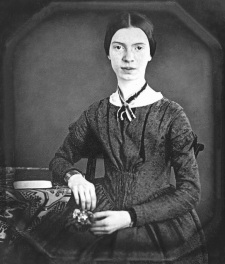 It is Dickinson’s ability to communicate the intensity of the experience that makes this poem live on in readers’ minds. But it is her ambiguous linguistic choices that leave it open to interpretation. She has taken a personal experience and made it universal, relevant to us all. The result is powerful because the poem has the capacity to speak to us about our own lives; it provokes thought and forces us to be active readers.
It is Dickinson’s ability to communicate the intensity of the experience that makes this poem live on in readers’ minds. But it is her ambiguous linguistic choices that leave it open to interpretation. She has taken a personal experience and made it universal, relevant to us all. The result is powerful because the poem has the capacity to speak to us about our own lives; it provokes thought and forces us to be active readers.








 The poem is written in the present tense and the verb phrases are dynamic, carrying us through the intense experience at the heart of the poem. But there is no context. We have no idea of the occasion, the time or the place, and this makes the events ambiguous. Instead, we have to rely on the connotations of the verbs to interpret the process.
The poem is written in the present tense and the verb phrases are dynamic, carrying us through the intense experience at the heart of the poem. But there is no context. We have no idea of the occasion, the time or the place, and this makes the events ambiguous. Instead, we have to rely on the connotations of the verbs to interpret the process. the way we respond to the verbs. The prepositional phrase by degrees appears to challenge the immediacy of the verb stuns: it makes the action seem tortuous – this is no bolt gun to the head; this is a slow and visceral process. A similar effect is achieved by the dashes and repeated time (Then) and place (further, nearer) adverbials which delay the final main clause. The style builds tension by creating physical space between Prepares … and Deals …. The male protagonist seems to be playing with his victim, like a cat with a mouse. The fronted adverbials and the lack of any coordination between the main clauses make the events of the poem seem unstoppable.
the way we respond to the verbs. The prepositional phrase by degrees appears to challenge the immediacy of the verb stuns: it makes the action seem tortuous – this is no bolt gun to the head; this is a slow and visceral process. A similar effect is achieved by the dashes and repeated time (Then) and place (further, nearer) adverbials which delay the final main clause. The style builds tension by creating physical space between Prepares … and Deals …. The male protagonist seems to be playing with his victim, like a cat with a mouse. The fronted adverbials and the lack of any coordination between the main clauses make the events of the poem seem unstoppable.
 poem, moving us from the personal to the cosmic. The natural image creates opposition between the concrete nouns Winds and Forests, mirroring the dynamic between the undefined He and you: subject and object; active agent and passive victim. The destructive potential of the Winds as a force of nature is ever-present, yet the verb take is a surprisingly gentle choice given what has gone before. The result is both frightening and tender: a sort of delightful horror, a sort of tranquillity tinged with terror (to quote Edmund Burke’s treatise on the sublime). Awe. Reverence. Respect. These are certainly the qualities that Dickinson’s poem inspires.
poem, moving us from the personal to the cosmic. The natural image creates opposition between the concrete nouns Winds and Forests, mirroring the dynamic between the undefined He and you: subject and object; active agent and passive victim. The destructive potential of the Winds as a force of nature is ever-present, yet the verb take is a surprisingly gentle choice given what has gone before. The result is both frightening and tender: a sort of delightful horror, a sort of tranquillity tinged with terror (to quote Edmund Burke’s treatise on the sublime). Awe. Reverence. Respect. These are certainly the qualities that Dickinson’s poem inspires. It is Dickinson’s ability to communicate the intensity of the experience that makes this poem live on in readers’ minds. But it is her ambiguous linguistic choices that leave it open to interpretation. She has taken a personal experience and made it universal, relevant to us all. The result is powerful because the poem has the capacity to speak to us about our own lives; it provokes thought and forces us to be active readers.
It is Dickinson’s ability to communicate the intensity of the experience that makes this poem live on in readers’ minds. But it is her ambiguous linguistic choices that leave it open to interpretation. She has taken a personal experience and made it universal, relevant to us all. The result is powerful because the poem has the capacity to speak to us about our own lives; it provokes thought and forces us to be active readers.
